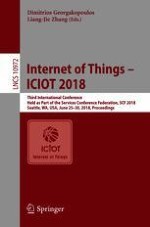2018 | Buch
Internet of Things – ICIOT 2018
Third International Conference, Held as Part of the Services Conference Federation, SCF 2018, Seattle, WA, USA, June 25-30, 2018, Proceedings
herausgegeben von: Dimitrios Georgakopoulos, Liang-Jie Zhang
Verlag: Springer International Publishing
Buchreihe : Lecture Notes in Computer Science
